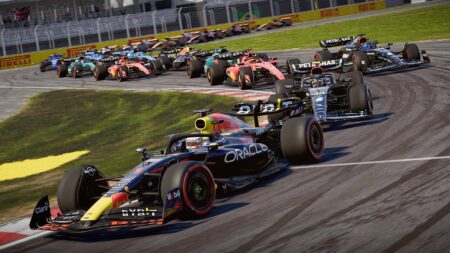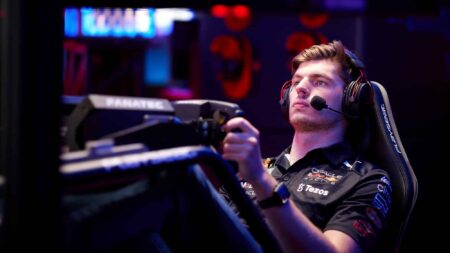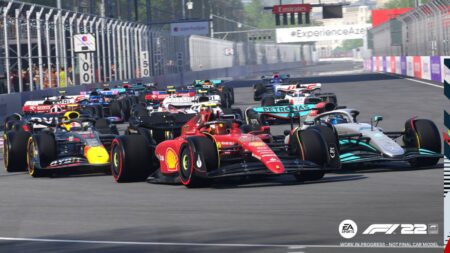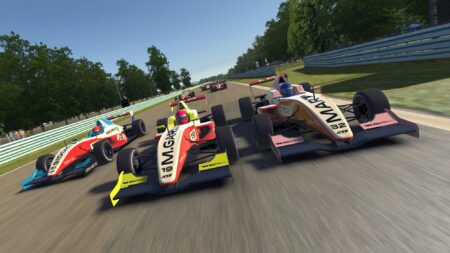
F1 23 review: racing rejuvenated or relapsed?
Our detailed review of the new F1 23 game including new features, new circuits and a brand new story mode
There are plenty of challenges to making a realistic MotoGP computer game that make the four-wheeled versions look easy…
MotoGP and motorcycling games are a world away from their four-wheeled virtual counterparts, but how do developers make the two-wheeled games feel realistic, if indeed they even can?
Luckily, R&D programmer Michele Caletti sat down to explain how MotoGP 18 took shape and what’s changed in this year’s release – out now on PS4, Xbox One, PC and Nintendo Switch.
“Well, a lot has changed,” he says. “This is the first year that we’re using the new Unreal game engine, which meant that we had to create everything from scratch. Everything from the menus to the physics to the Artificial Intelligence had to be redone as a result.”
Milestone had been using its own game engine but by switching to Unreal – technology once reserved for first-person shooters – it is now in line with the latest racing sims such as Assetto Corsa.
“We wanted to change a lot at gameplay level,” reasons Caletti for the change to the physics-based game engine.
“In MotoGP 18, we give the player a better feeling of the bike, with a more evident sense of weight. One of the most common complaints from real riders and professional gamers was that bikes were a bit too nimble at high speed when leaning, so we tried to convey a better sense of weight and risk into hard braking points.”
The more nuanced handling model shows in the game, so too the inclusion of engine braking – another fan request.
Caletti explains: “You don’t just use the mechanical brakes in MotoGP. And riders will adjust the engine braking during the race, so we modelled it in the game to allow the player to do so on the fly.”
How does this all get translated to a controller? Well, motorcycle games have been around a while, but there’s no equivalent to a racing wheel and pedals for a bike game for obvious reasons. But Caletti sees the controller fit for purpose, with the analogue accelerator and front brake working just fine. He reasons that the rear brake is almost binary (either fully on or off) on a MotoGP bike.
However, when it comes to translating that weight and feel of a bike back to the player, things become far more complicated.
“The most important thing to understand is that when you steer the wheel in a racing game, it’s instantaneous,” says Coletti. “It’s a 1:1 movement to what the driver is doing on screen.
“In a bike game, there are different layers to this. When you flick the thumbstick right, you’re telling the game that your rider, not your bike, wants to lean to the right. Then, the rider moves their body because steering is done by moving the mass of the rider and the bike, and so we have to make this dynamic intuitive. It’s much harder to do than in a car racing game.”
And Milestone has some experience of four-wheeled racing games, with 2018’s Gravel, Valentino Rossi and Sébastien Loeb’s respective licenced games in 2016 and the WRC series.
“Bikes have a high inertia because of the gyroscopic forces, so turning a bike at 200kmh is a physical effort. What we do is not to make turning the bike super quick but to make it realistic so that all the forces are modelled,” he says.
“Turns are best approached with some anticipation, and you have to be able to predict what’s going to happen if you move the stick or triggers. It’s not simple, but it’s intuitive – you can almost ride by instinct rather than reaction as to what’s happening on screen.”
The developer has a prolific track record producing motorcycle games, with the Ride titles under its belt, a host of motocross and Supercross games and the MotoGP series.
With that, Milestone has stored a library of motion capture data from riders, which means that the animations in this title are more or less seamless – which is important. In football terms, think FIFA 18 versus Sensible Soccer. Smoother animations go for falling riders as well…
“The crucial point is blending the animations,” explains Coletti. “If you do a simple thing like lean to the right, there are several postures and animations: that of the knees, the torso, the upper body, the head, the back of the body and the front of the body – and then they all change at each stage of the corner.
“It’s a very complex task, blending all the different movements that we have so that they’re realistic, but the goal is to make something that’s continuously moving and continuously animated through the corner.”
Consider that each rider has different riding styles (elbows out, upright and more), then Milestone’s task seems much, much tougher.
That motorcycle experience works in its favour when it comes to scanning tracks. Whereas titles such as iRacing or Assetto Corsa use lasers to scan tracks, Milestone just couldn’t fit a van topped with a laser scanner onto jump-laden Supercross or motocross circuits, so it needed a solution: drones.
“We fly drones over tracks that take thousands of pictures, and they feed pictures into the software that goes on for hours and hours and reconstructs a picture similar to that of laser scanning,” explains Coletti.
The result is similar in precision to that of laser-scanning, and, for the first time in the Milestone MotoGP series, precision is down to a few centimetres. Drones cover more ground and paint a larger picture as well, which helps on larger, sprawling tracks. Plus, Milestone no longer has to depend on track maps and data supplied by owners, which can be imprecise.
A push towards esports completes the MotoGP 18 package, although no teams are officially involved in the MotoGP esports tournament. But the tools are included now, with a spectator mode for the curious and streamers on Twitch and YouTube, and official tournaments are to come later this year. Last year’s MotoGP esports championship, for example, handed the overall winner a BMW 240i, with the final broadcast live by Dorna’s TV partners.
What about the execution of MotoGP 18? A full review will follow soon.
But what we can tell you is that Caletti’s team is incredibly passionate about its motor sport.
“You can’t expect everybody from the receptionist to the technical director to be passionate about MotoGP, but many of the key people on this project are, and it’s the same with every project that we do,” he explains.
“Some of the guys from the design team just came back from a full weekend camping at Mugello, and I was there watching from San Donato.
“When riders come to Milestone, we sit with them and talk about the techniques of riding, engineering and everything in between, because you have to be totally into motor sport to make a competent game out of it.”

Our detailed review of the new F1 23 game including new features, new circuits and a brand new story mode

Max Verstappen quit the 2023 Virtual Le Mans 24 Hours and labelled it a "clown show" after connection issues, but many say that technical issues are simply part of sim racing

A new era of F1 cars, complete challenges in supercars and VR compatible are key features for this year's game and more

Esports has long been viewed as insignificant but 'old views' need to change according to some drivers